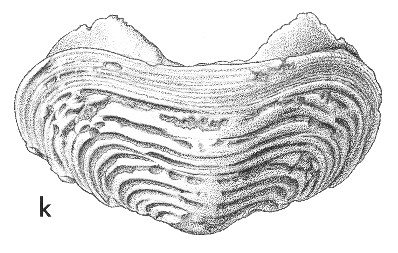
Revised descriptions of New Zealand Cenozoic Mollusca from Beu and Maxwell (1990)

 | Revised descriptions of New Zealand Cenozoic Mollusca from Beu and Maxwell (1990) | 
|
  (Pl. 43h): Ohope Beach, Whakatane, Castlecliffian (National Museum of N.Z.; small median posterior valve, form marmoratus) |
  (Pl. 43f): Ohope Beach, Whakatane, Castlecliffian (National Museum of N.Z.; small posterior valve, form marmoratus) |
  (Pl. 43k): GS158, O32/f9038, Pleistocene terrace remnant at 170 m altitude, north end of Amuri Bluff, Marlborough, Haweran (GNS; large median valve) |
Beu & Maxwell (1990): Chapter 16; p. 330; pl. 43 f ,h,k.
Synonymy: Chiton undulatus Quoy & Gaimard 1835, p. 393 (not of Wood, 1828); Tonicia lineolata "Frembly" of Hutton 1880, p. 114 (not of Frembly, 1828); Onithochiton neglectus Rochebrune 1881, p. 120; Onithochiton astrolabei Rochebrune 1881, p. 120; Onithochiton filholi Rochebrune 1881, p. 120; Onithochiton decipiens Rochebrune 1882, p. 196; Onithochiton semisculptus Pilsbry 1894, p. 425; Onithochiton marmoratus Wissel 1904, p. 658; Onithochiton nodosus Suter 1907c, p. 297; Onithochiton opiniosus Iredale & Hull 1932, p. 159; Icoplax chathamensis Dell 1960, p. 153; Onithochiton undulatus; Tonicia undulata; Anthochiton (Nodiplax) chathamensis; Rhyssoplax (Nodiplax) chathamensis
Type species of Onithochiton Gray, 1847, and of Nodiplax Beu, 1967 (= Onithochiton Gray, 1847)
Classification: Chitonidae
Description: Small to moderate-sized (fossil median plates to 12 mm wide and 7.3 mm long), second valve markedly longer than valves 3-8; tegmentum uniformly pink in juvenile forms (smooth and structureless in fossils), brightly striped with commarginal alternate cream and dark green bands in most modern adults (remaining brown and white in some fossils, and white bands eroding away differentially, so it seems likely that green bands are calcite and cream bands are aragonite). Anterior valve semicircular, with 8 slits, insertion plates short and thick, finely denticulate. Median valves very short and wide, with 1 slit in each edge. Posterior valve small, triangular, with terminal mucro; posterior edge thick, callused, smooth, without slits. Sculpture of radial rows of low, rounded nodules on anterior valve and on lateral areas of valves 2-7, highly variable in prominence, commonly seen on polished, pink juvenile form (= O. marmoratus, O. nodosus, I. chathamensis) but absent from most adult shells.
Comparison: The uniform pink, nodulous juvenile form of Onithochiton neglectus (Pl. 43f, h) has often been placed in a different genus and family from the smooth cream and green adult, but O'Neill (1984,1985) studied growth series and revised the taxonomy of New Zealand Onithochiton, confirming that the sculptured pink juvenile grows up to become the smooth cream and green adult.
Distribution: Mangapanian-Recent; Recent, New Zealand (types of all names in the above synonymy). A common chiton under boulders on exposed rocky shores throughout New Zealand, and in the Subantarctic Islands (where adults are uniformly brown, so recognised as the geographical subspecies O. neglectus subantarcticus Suter, 1906) and dredged in a few metres of water, but a most uncommon fossil. Specimens have been seen from T23/f6565, OU8122, Te Ekaou Stream, Pohangina, eastern Wanganui basin (Mangapanian; Otago University Geology Dept), from Ohope Beach, Whakatane (Castlecliffian; juvenile marmoratus form, illustrated; NMNZ), and from GS158, high "raised beach", Amuri Bluff, Marlborough, coll. A. McKay (20 large valves; early Haweran).
Cite this publication as: "A.G. Beu and J.I. Raine (2009). Revised
descriptions of New Zealand Cenozoic Mollusca from Beu and Maxwell (1990). GNS
Science miscellaneous series no. 27."
© GNS Science, 2009
ISBN
978-0-478-19705-1
ISSN 1177-2441
(Included with a PDF facsimile file
copy of New Zealand Geological Survey Paleontological Bulletin 58 in CD version
from: Publications Officer, GNS Science, P.O. Box 30368 Lower Hutt, New
Zealand)